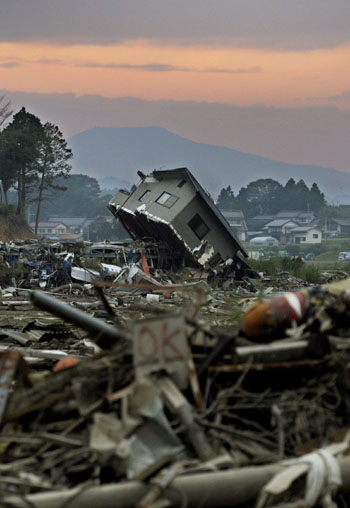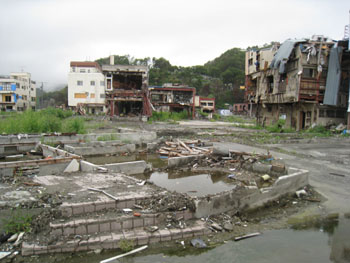Six months after earthquake and tsunami, few signs of recovery
Progress held back by debris, lack of jobs and slow planning
| Out of the wreckage: A destroyed house sits among debris from the March 11 earthquake and tsunami in Kesennuma, Iwate Prefecture, on Friday. Below: A family prays for the deceased at a memorial in Natori, Miyagi Prefecture, the same day. KYODO PHOTOS |
But the light coming from a convenience store that reopened in late July has become a symbol of hope for the community.
“Unless people start reopening their businesses, the town will never take the first steps toward reconstruction,” said Taiko Tanisawa, the 63-year-old owner of the reopened Marutani store, as she warmly greeted customers.
While Tanisawa and her family survived the catastrophe, her house and the store she ran since 1994 were destroyed by the tsunami and an ensuing fire caused by a propane gas leak.
The March 11 disasters killed 799 of Otsuchi’s 16,000 residents, including the mayor, and a further 608 were still missing as of the end of August. In addition, the tsunami either destroyed or damaged about 70 percent of the town’s homes.
“I felt that we should not remain in Otsuchi,” said Tanisawa, who after March 11 considered leaving the town with her family and making a fresh start somewhere else. But she ultimately changed her mind because her neighbors kept encouraging her to reopen. She hopes the locals will interpret her reopened business as a step toward reconstructing the devastated town, even though the new store is only one-fifth the size of the previous one.
Six months after the 9.0-magnitude quake and subsequent tsunami killed more than 15,700 people and left nearly 4,100 missing in the Tohoku region, survivors are trying to move forward and rebuild their shattered lives and communities.
In the worst-hit coastal regions of Iwate and Miyagi prefectures, various restoration efforts have made progress, such as building temporary accommodations for evacuees who lost their homes and had to live in shelters, restoring crippled infrastructure and clearing debris in commercial and residential areas.
But the massive piles of debris kept in temporary storage sites along the coast are just one indicator that a huge amount of work remains to be done.
Creating new jobs is a priority, as many people who worked for businesses that were wrecked in March remain unemployed. A recent labor ministry survey showed that at least 70,000 people in Iwate, Miyagi and Fukushima prefectures lost their jobs because of the quake-tsunami catastrophe.
The pace of recovery is slowest in Fukushima Prefecture, where the crisis at the crippled No. 1 nuclear station has forced thousands of residents in the government-set 20-km no-go zone around the leaking plant, as well as some living in radioactive hot spots outside the zone, to evacuate their homes. It remains unclear when, or even if, they will be able to return to their hometowns.
The central and local governments have set a 10-year goal to fully restore disaster-hit areas in the devastated northeast, and plans to rebuild ruined communities have finally started to move forward.
But rebuilding Tohoku won’t come cheap.
According to the central government’s basic reconstruction plan released July 29, reconstruction costs will total at least ¥23 trillion over the coming decade, and cash-strapped local governments are asking the state to finance the bulk of those expenditures.
Experts say rebuilding disaster areas is not simply a matter of returning them to their predisaster state. Redesigning towns and cities must take into account the probability that another monster tsunami will someday strike the region, they say. In addition, plans must factor in the aging populations of the disaster-hit communities, which even before March 11 were shrinking as residents aged and the young moved away in search of work.
“What we need to do is design cities (and towns) in which people can live comfortably and safely,” said Arata Endo, an associate professor at Kogakuin University and an expert on urban planning. “We must make them better places to live in than before, as the size of the communities shrinks.”
Since May, Endo has led a committee that includes architects, disaster management experts and local resident representatives to draw up a plan for rebuilding wrecked districts in the city of Kamaishi, Iwate Prefecture.
The committee is seeking to produce a blueprint of how Kamaishi should ideally look in 20 years’ time, Endo said.
He stressed that it is crucial to solicit residents’ ideas, even though it may not be possible to include them all in the final plan.
The committee will submit its plan later this month to Kamaishi’s disaster rebuilding committee for approval. Providing it gets the green light, the municipal assembly — which was slated to hold an election Sunday — will hammer out the plan’s details.
| Glimmer of hope: Almost six months after the March disasters, no signs of rebuilding can be seen in Otsuchi, Iwate Prefecture, on Sept. 2. Below: Taiko Tanisawa poses in her Marutani convenience store Sept. 3, which she reopened in Otsuchi in a prefabricated building. TAKAHIRO FUKADA PHOTOS |
In the case of Otsuchi, however, recovery and rebuilding efforts have been delayed by the loss of the mayor and dozens of municipal officials in the March disasters. A new mayor wasn’t elected until the end of August.
In the meantime, some residents decided to stand up and take matters into their own hands. In May, Otsuchi native Tomohiro Akazaki and others created a resident council to gather suggestions for rebuilding their ruined town.
“I wanted to be part of rebuilding my hometown. It will be really sad if it disappears,” said Akazaki, 33.
The council held six rounds of discussions with residents and submitted its rebuilding suggestions to Otsuchi’s municipal office in July.
“The town office may ignore the opinion of a single residentbut hopefully they will listen to a group of residents,” Akazaki said.
Of the projected ¥23 trillion reconstruction budget for the next decade, the central government plans to spend ¥19 trillion in the first five years. This includes ¥6 trillion that already has been secured in the first and second extra budgets for fiscal 2011, and Prime Minister Yoshihiko Noda’s new administration is aiming to submit a third supplementary budget to the Diet in October.
To cover the costs, the government is considering hiking taxes, although no decision has been made on which ones to target.
Kogakuin University’s Endo said the central government must decide swiftly on the projects to be financed by the budget, so that local governments can soon start their rebuilding efforts.
Back in Otsuchi, Tanisawa said she is worried about the town’s future as she fears that many young residents who lost their jobs in the disasters will move away, accelerating Otsuchi’s depopulation. In terms of rebuilding the town, Tanisawa called for more streetlights, because the darkness of the blacked-out town frightens her at night.
“If someone tries to attack my store, no one would come to help me,” she said. Due to safety concerns, she closes her new store at 8 p.m. — her previous business stayed opened until 11 p.m.
“My old neighbors, who are now living in temporary housing far away, also hope to return to their original neighborhoods,” she said. “I hope residents will eventually return, and the town will again shine brightly.”





It is very sad but people with hope can do anything. They seam to be trying.
This is dishearting knowing how industrious the Japanese people are.